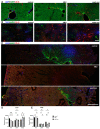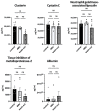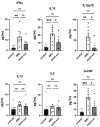4-Methylumbeliferone Treatment at a Dose of 1.2 g/kg/Day Is Safe for Long-Term Usage in Rats
- PMID: 36835210
- PMCID: PMC9959083
- DOI: 10.3390/ijms24043799
4-Methylumbeliferone Treatment at a Dose of 1.2 g/kg/Day Is Safe for Long-Term Usage in Rats
Abstract
4-methylumbelliferone (4MU) has been suggested as a potential therapeutic agent for a wide range of neurological diseases. The current study aimed to evaluate the physiological changes and potential side effects after 10 weeks of 4MU treatment at a dose of 1.2 g/kg/day in healthy rats, and after 2 months of a wash-out period. Our findings revealed downregulation of hyaluronan (HA) and chondroitin sulphate proteoglycans throughout the body, significantly increased bile acids in blood samples in weeks 4 and 7 of the 4MU treatment, as well as increased blood sugars and proteins a few weeks after 4MU administration, and significantly increased interleukins IL10, IL12p70 and IFN gamma after 10 weeks of 4MU treatment. These effects, however, were reversed and no significant difference was observed between control treated and 4MU-treated animals after a 9-week wash-out period.
Keywords: 4-methylumbelliferone; chondroitin sulphates; hyaluronan; neuroplasticity.
Conflict of interest statement
Kwok has a patent ‘Treatment of Conditions of the Nervous System’ (PCT/EP2020/079979) issued.
Figures









References
-
- Dubisova J., Burianova J.S., Svobodova L., Makovicky P., Martinez-Varea N., Cimpean A., Fawcett J.W., Kwok J.C., Kubinova S. Oral treatment of 4-methylumbelliferone reduced perineuronal nets and improved recognition memory in mice. Brain Res. Bull. 2022;181:144–156. doi: 10.1016/j.brainresbull.2022.01.011. - DOI - PMC - PubMed
MeSH terms
Substances
Grants and funding
LinkOut - more resources
Full Text Sources

